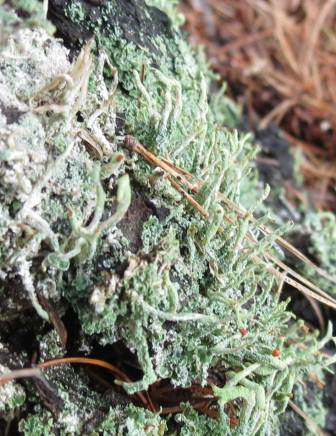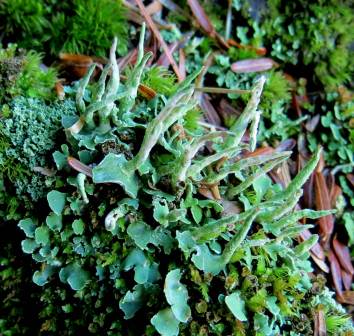I haven’t said much about mosses lately but since now is the time they are most easily seen I thought I’d get out there and see what I could find. Rose moss (Rhodobryum roseum) is one of the most beautiful mosses in my opinion, and gets its common name from the way that each plant looks like a tiny rose blossom. Rose moss is also a good indicator of your surroundings because it prefers growing in lime rich soil or on limestone boulders.
Can you tell which of these boulders have limestone in them? I can’t either but rose moss can, and it grows on just two of them.
Stair-step moss (Hylocomium splendens) is another very pretty moss that looks quite fragile, but I’ve seen it with icicles hanging from it and I can say with certainty that it’s a lot tougher than it looks. That is most likely why it grows as far north as the arctic tundra. When dry this moss has a slight satiny sheen to it, and that’s probably how it came by its other common name of glittering wood-moss.
Stair step moss gets its name from the way the new growth “steps up” off the midrib of the previous year’s branch. Each year a new branch grows from the old and this growth habit allows stair step moss to grow up and over other mosses. You can tell the age of the moss by counting these steps.
What I think is yellow feather moss (Homalothecium lutescens) always looks pale and kind of sickly, but if you look closely at its growing tips and new spore capsules you’ll find that it quite healthy. If you see it at all, that is; I know of only one small colony that grows on the very end of a log with a diameter of an average doughnut, and I’ve never found it anywhere else.
It’s easy to see how white tipped moss (Hedwigia ciliata) got its common name. This is a fairly common moss that seems to like to hang from the sides of boulders and ledges. Another name for it is Medusa moss, because when dry its leaves press close to the stem and it takes on a very wiry, string like appearance. Its ball shaped orange spore capsules (sporophytes) are hidden among the leaves on very short stalks, so they’re hard to see. This moss will even grow on asphalt roofs, so it is a perfect choice for green roof projects.
Delicate fern moss (Thuidium delicatulum) is another pretty moss but I’m not sure how it comes by its common name because it is far from delicate. I have a few patches of it growing in my back lawn that get mowed and walked on regularly and they thrive in spite of the abuse. The leaves of this moss grow more horizontally than vertically and it often forms very low, dense mats on logs or the forest floor in damp, shaded places.
Some “mosses” might have to be looked at a little closer.The growth on this stone isn’t a moss at all, though from a distance it looks just like one. It’s actually a liverwort called greater whipwort (Bazzania trilobata) and it grows right alongside mosses.
Up close greater whipwort looks as almost if it has been braided. Each leaf on this leafy liverwort is only about an eighth of an inch wide and has three triangular notches at its base. This is where the trilobata part of the scientific name comes from. It means “having three lobes.”
Something else often found growing on boulders right beside mosses is rockfoam lichen (Stereocaulon saxatile.) Mosses soak up moisture like a sponge when it rains and then release it slowly and lichens often take advantage of this. The best time to search for both lichens and mosses is after a rain because both are at their best when wet.
Haircap moss (Polytrichum commune) gets its name from the hairy covering (calyptra) on its spore capsules (sporophytes). It is a very common moss that grows in dense colonies of 2-4 inches tall, often mounded in the center. The sheaths on its leaves can be golden yellow and shiny and give this moss another common name of goldilocks. I see it almost everywhere I go.
Haircap moss spore capsules start life round bat as they age become almost square and winged. The example in this photo still has its end cap or lid, called an Operculum, in place. This means that it hasn’t released its spores yet. I’m not sure what caused the blue color but this is the only blue spore capsule that I’ve seen.
One reason I don’t do more posts on mosses even though they fascinate me is because they can be difficult to identify without a microscope and many of them look very similar. A good example of that is what I think is this narrow leaved beard moss (Helodium paludosum.) It looks a lot like the Hedwigia ciliata we looked at earlier, but without the white tips.
The reason I wanted to show this moss is because of the immature spore capsules (sporophytes). When young the sporophyte is completely surrounded by a tough protective covering called the calyptra. The calyptra is what gives the spore capsules in the above photo their whitish color. As the sporophytes grow their skin-like calyptras will be shed, revealing their reddish brown color. So, if you find a moss with white spore capsules you know that you are actually seeing its immature capsules.
Brocade Moss (Hypnum imponens) is very shiny and sometimes has an orange brown color. Its common name comes from the way it looks as if it has been embroidered on whatever it happens to be growing on. It is easily confused with knight’s plume moss (Ptilium crista-castrensis,) but the spore capsules on knights plume moss are elbow macaroni shaped and horizontal, while those of brocade moss are cylindrical and stand vertically, as seen in the above photo.
Mosses often change color when it gets colder and this delicate fern moss surprised me with what I thought was its bright orange color. My color finding software told me it was just my color blindness again, because it is really lime green. It is a very bright lime green though, and was shining like a beacon.
I hope I didn’t bore all of you to tears talking about mosses. Soon there will be very little besides moss that is still green, and for me there are few things more pleasurable than walking through the snowy winter woods with a bright blue sky overhead and the sunshine falling on some of the only green things to be seen. Mosses, lichens, liverworts, and a few evergreen ferns are part of what make nature study fun even in winter.
Nature conceals her secrets because she is sublime, not because she is a trickster. ~Albert Einstein
Thanks for stopping in.
















 This is also a beard lichen called bristly beard (Usnea hirta.) many lichens grow so slowly that they can take decades to grow a fraction of an inch. They are thought to be among the oldest living things on earth.
This is also a beard lichen called bristly beard (Usnea hirta.) many lichens grow so slowly that they can take decades to grow a fraction of an inch. They are thought to be among the oldest living things on earth.


 Common powderhorn lichens (Cladonia coniocraea) look just like lipstick powderhorns, but without the red tip. The spores are released from the pointed tip. These were also growing on a decaying log.
Common powderhorn lichens (Cladonia coniocraea) look just like lipstick powderhorns, but without the red tip. The spores are released from the pointed tip. These were also growing on a decaying log.







